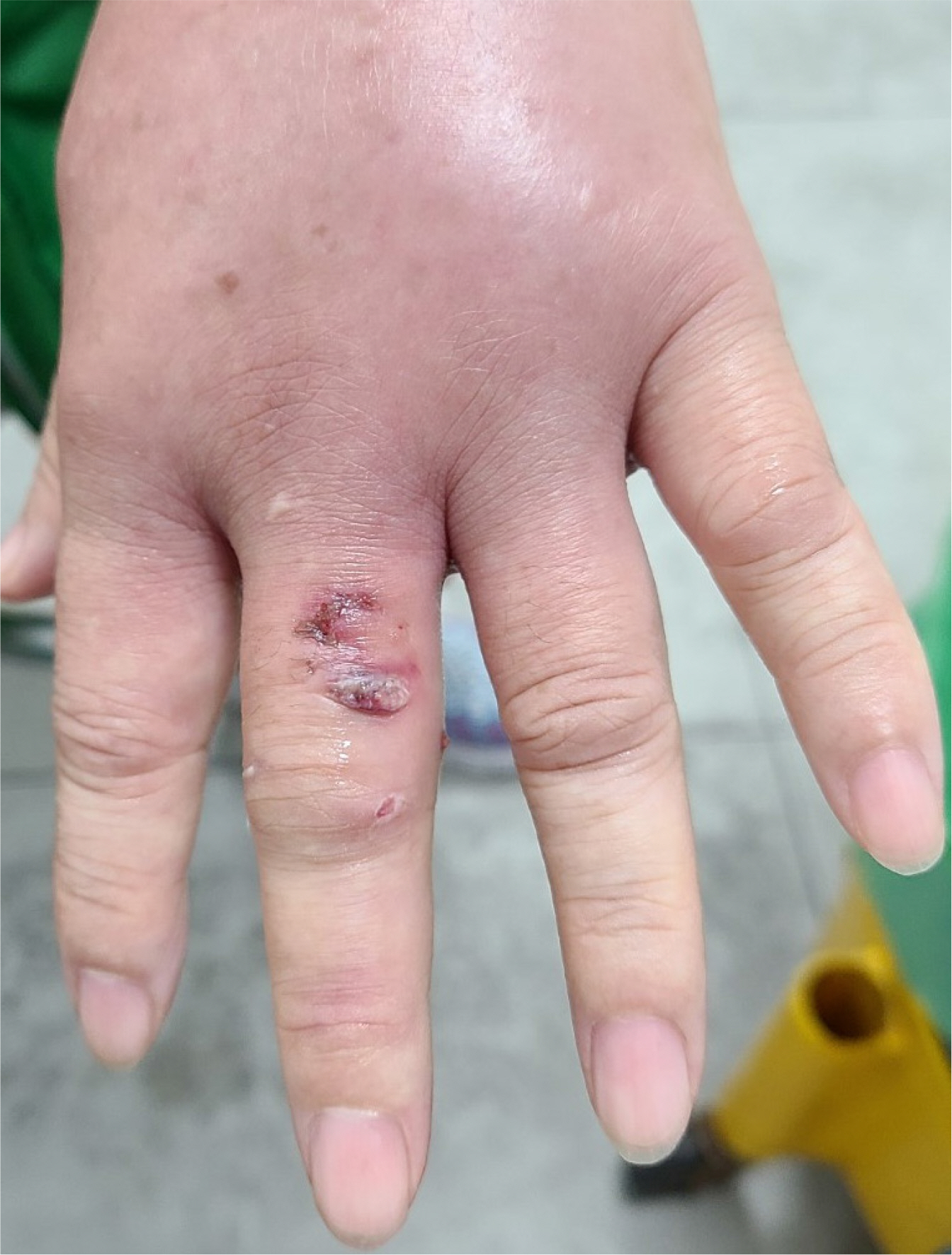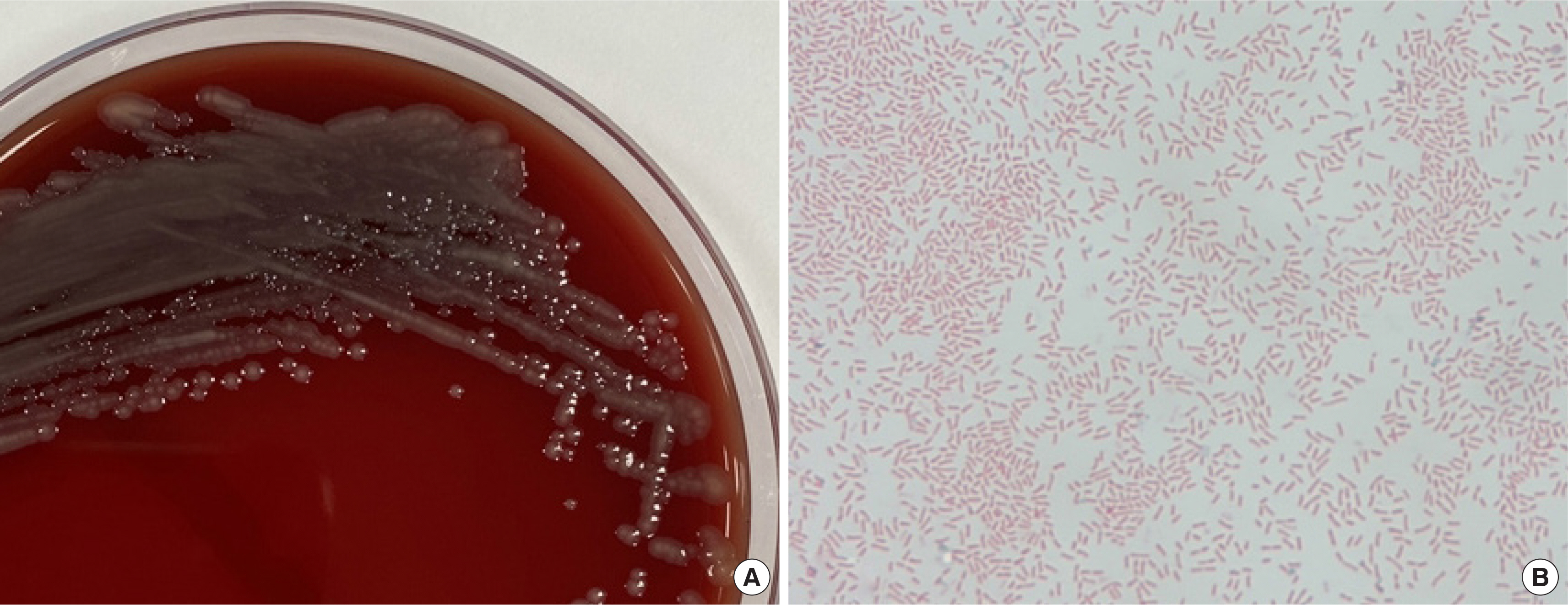Lab Med Online.
2021 Jan;11(1):73-77. 10.47429/lmo.2021.11.1.73.
A Case of Bergeyella zoohelcum Isolated from a Patient with Cellulitis after a Dog Bite
- Affiliations
-
- 1Department of Laboratory Medicine, Seoul National University College of Medicine, Seoul, Korea
- 2Department of Laboratory Medicine, Seoul National University Hospital, Seoul, Korea
- 3Department of Internal Medicine, Seoul National University Hospital, Seoul, Korea
- 4Department of Laboratory Medicine, Seoul National University Boramae Medical Center, Seoul, Korea
- KMID: 2525785
- DOI: http://doi.org/10.47429/lmo.2021.11.1.73
Abstract
- Bergeyella zoohelcum is an aerobic gram-negative bacillus frequently found in the normal oral flora of mammals. It rarely causes human infection; most reported infection cases were associated with animal bites. In this study, we report a case of cellulitis after a dog bite caused by B. zoohelcum. A sixty-six-year-old woman presented to the hospital due to soft tissue infection (a finger); the woman was bitten by a dog two days prior to the hospital visit. Gram-negative bacilli were isolated from pus cultures; identified via MALDI-TOF MS, 16s rRNA sequencing, and automated identification systems revealed B. zoohelcum. This is the first report of an infectious disease caused by B. zoohelcum in Korea.
Keyword
Figure
Reference
-
1. Yi J, Humphries R, Doerr L, Jerris RC, Westblade LF. 2016; Bergeyella zoohelcum associated with abscess and cellulitis after a dog bite. Pediatr Infect Dis J. 35:214–6. DOI: 10.1097/INF.0000000000000971. PMID: 26535880.2. Chen Y, Liao K, Ai L, Guo P, Huang H, Wu Z, et al. 2017; Bacteremia caused by Bergeyella zoohelcum in an infective endocarditis patient: case report and review of literature. BMC Infect Dis. 17:271. DOI: 10.1186/s12879-017-2391-z. PMID: 28403835. PMCID: PMC5389159.
Article3. Muramatsu Y, Haraya N, Horie K, Uchida L, Kooriyama T, Suzuki A, et al. 2019; Bergeyella zoohelcum isolated from oral cavities of therapy dogs. Zoonoses Public Health. 66:936–42. DOI: 10.1111/zph.12644. PMID: 31464049.4. Sharma S, Salazar H, Sharma S, Nasser MF, Dahdouh M. 2019; Bergeyella zoohelcum bacteremia from therapy dog kisses. Cureus. 11:e4494. DOI: 10.7759/cureus.4494.5. Mulliken JS, Langelier C, Budak JZ, Miller S, Dynerman D, Hao S, et al. 2019; Bergeyella cardium: Clinical characteristics and draft fenome of an emerging pathogen in native and prosthetic valve endocarditis. Open Forum Infect Dis. 6:ofz134. DOI: 10.1093/ofid/ofz134. PMID: 31024974.
Article6. Kivinen P, Lahtinen MR, Ruotsalainen E, Harvima IT, Katila ML. 2003; Bergeyella zoohelcum septicaemia of a patient suffering from severe skin infection. Acta Derm Venereol. 83:74–5.7. Lin WR, Chen YS, Liu YC. 2007; Cellulitis and bacteremia caused by Bergeyella zoohelcum. J Formos Med Assoc. 106:573–6. DOI: 10.1016/S0929-6646(07)60008-4.8. Grimault E, Glerant JC, Aubry P, Laurans G, Poinsot JP, Jounieaux V. 1996; Uncommon site of Bergeyella zoohelcum. Apropos of a case. Rev Pneumol Clin. 52:387–9.9. Bracis R, Seibers K, Julien RM. 1979; Meningitis caused by group II J following a dog bite. West J Med. 131:438–40.10. Vandamme P, Bernardet J-F, Segers P, Kersters K, Holmes B. 1994; New Perspectives in the Classification of the Flavobacteria: Description of Chryseobacterium gen. nov., Bergeyella gen. nov., and Empedobacter nom. rev. Int J Syst Bacteriol. 44:827–31. DOI: 10.1099/00207713-44-4-827.11. Sohn KM, Huh K, Baek JY, Kim YS, Kang CI, Peck KR, et al. 2015; A new causative bacteria of infective endocarditis, Bergeyella cardium sp. nov. Diagn Microbiol Infect Dis. 81:213–6. DOI: 10.1016/j.diagmicrobio.2014.12.001. PMID: 25544000.12. Zamora L, Domínguez L, Fernández-Garayzábal JF, Vela AI. 2016; Bergeyella porcorum sp. nov., isolated from pigs. Syst Appl Microbiol. 39:160–3. DOI: 10.1016/j.syapm.2016.03.006. PMID: 27039167.13. Shukla SK, Paustian DL, Stockwell PJ, Morey RE, Jordan JG, Levett PN, et al. 2004; Isolation of a fastidious Bergeyella species associated with cellulitis after a cat bite and a phylogenetic comparison with Bergeyella zoohelcum strains. J Clin Microbiol. 42:290–3. DOI: 10.1128/JCM.42.1.290-293.2004. PMID: 14715767. PMCID: PMC321680.14. Beltran A, Bdiiwi S, Jani J, Recco RA, Go EE, Zaman MM. 2006; A case of Bergeyella zoohelcum bacteremia after ingestion of a dish prepared with goat blood. Clin Infect Dis. 42:891–2. DOI: 10.1086/500457. PMID: 16477574.15. Lee JY, Lee SY, Cho EH. 2019; Results of animal-bite and rabies case surveillance in South Korea, 2018. PHWR. 12:58–62.16. Kwak YG, Choi S-H, Kim T, Park SY, Seo S-H, Kim MB, et al. 2017; Clinical guidelines for the antibiotic treatment for community-acquired skin and soft tissue infection. Infect Chemother. 49:301–25. DOI: 10.3947/ic.2017.49.4.301. PMID: 29299899. PMCID: PMC5754343.
Article17. Lin J-N, Lai C-H, Yang C-H, Huang Y-H, Lin H-F, Lin H-H. 2017; Comparison of four automated microbiology systems with 16S rRNA gene sequencing for identification of Chryseobacterium and Elizabethkingia species. Sci Rep. 7:13824. DOI: 10.1038/s41598-017-14244-9. PMID: 29062009. PMCID: PMC5653830.
Article18. Dash N, Al-Zarouni M, Rattan A, Panigrahi D. 2012; Misidentification of Brucella melitensis as Bergeyella zoohelcum by MicroScan WalkAway®: a case report. Med Princ Pract. 21:495–7. DOI: 10.1159/000338391. PMID: 22614245.
- Full Text Links
- Actions
-
Cited
- CITED
-
- Close
- Share
- Similar articles
-
- The epidemiologic characteristics of dog-bite injury during COVID-19 pandemic in Korea
- A Case of Forehead Flap Nasal Reconstruction for Dog Bite Nasal Injury
- Scrotal dog bite and mismatch between the skin and testis injury: a case report and review of literature
- Replantation for Amputation of the Finger by a Dog Bite
- Acute Osteomyelitis in the Hand Due to Dog Bite Injury: A Report of 3 Cases



